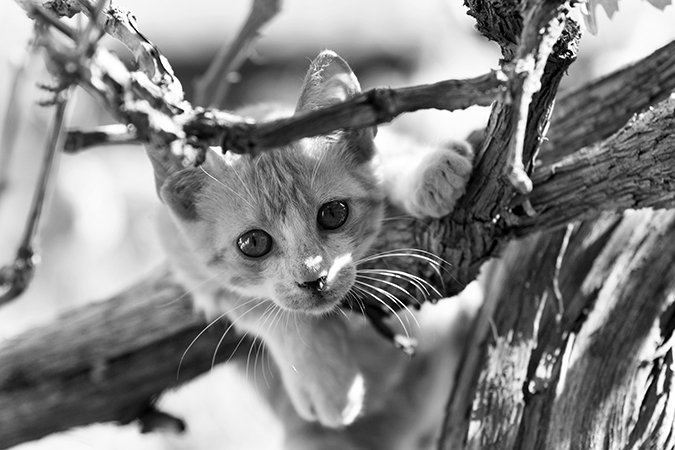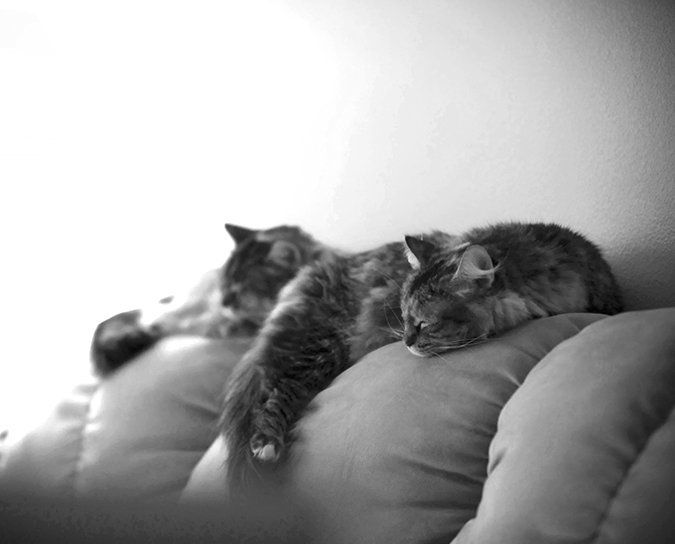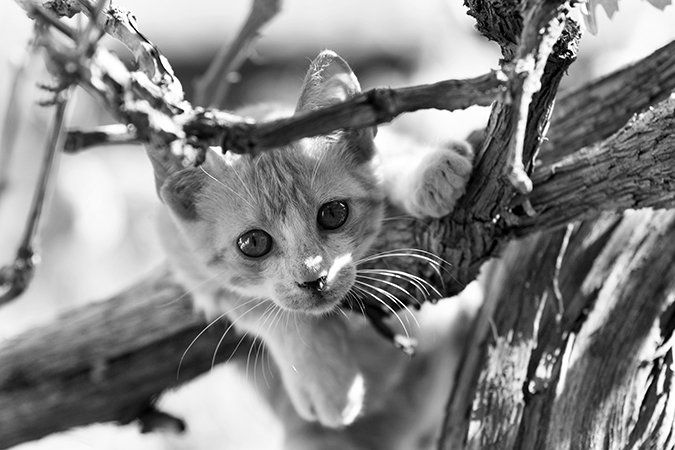THINKSTOCK

One of the most delightful aspects of our domestic cats is their lifelong love of play. Inside every cat — no matter how pampered, sedentary (or even downright lazy) — beats the heart of a mighty hunter. Many cat owners assume that their adult cats don’t want (or need) regular playtime, because they typically show so little interest in the toys that are available to them, or because they spend so much time just lazing around or sleeping. Actually, nothing could be further from the truth!
For cats who enjoy an exclusively indoor lifestyle, daily interactive play is particularly vital. “We’ve taken away our indoor cats’ ability to engage in a natural (but dangerous) life outside, and their ability to engage in species-typical behaviors,” says Nicholas Dodman, BVMS, Director of the Animal Behavior Clinic at Tufts Cummings School of Veterinary Medicine and author of The Cat Who Cried for Help. “Therefore, we need to offer effective substitutes. Part of our job as caring owners is to provide opportunities for indoor cats to behave like cats — rather than just sitting around, waiting for their next meal.”
Why play is so important
In fact, active play is really a vital part of every cat’s regular health care. Daily, vigorous “mock-hunting” play — both solo and interactive — keeps cats physically toned, mentally sharp and psychologically healthy. Every cat needs to stalk, leap, pounce, swat and chase. For a cat of any age, play is serious business. Without a stimulating environment and plenty of opportunity to exercise their bodies, minds and imaginations, cats can get bored, depressed, overweight — and even ill.
That’s where you can step in. No matter how many toys he has lying around the house, or how fancy or high-tech they are, your cat’s favorite play partner is you. While you might see your cat chase, bat and pounce on his toys, you haven’t really seen what your small hunter is capable of until you pick up an interactive toy and bring it to life.
It’s easy enough to manage vigorous play sessions with a single cat. But what about multi-cat families? Whether you have two, five or a dozen cats, you can — and should — treat each and every one of them to at least one session each day of active, mock-hunting play. It’s essential for your cats — and it’s great fun for you, too, as well as terrific mental and physical exercise.

Toys that cats love
First, put together a selection of interactive toys. Dr. Dodman suggests wands with string and feathers attached, or anything that moves. A small, hand-held laser pointer, with its maddeningly elusive red dot, is an interactive playtime standby. Never shine the light in or towards your cats’ (or your own) eyes, though.
Some of the best interactive toys we’ve found are the Feline Fisher (www.felinefisher.com) and Da Bird (www.go-cat.com.com). The Feline Fisher (formerly known and loved by millions of cats as the “Galkie Kitty Tease”) is particularly versatile.
Amazingly sturdy and deceptively simple, the Fisher can — in the hands of a skilled operator — simulate almost any kind of prey, from a skittering insect to a scurrying mouse, a jumping frog to a fluttering bird. The lure is simply a scrap of denim — but to cats, it’s pure magic.
“Da Bird,” also a longtime feline favorite, consists of a pair of feathers that dangle on a swivel at the end of a string. When whirled around in the air, this toy looks and sounds uncannily like a live bird. You won’t believe the flying leaps your cats are capable of until you see them go after Da Bird.
Next, select your play space. Ideally, you have an area that relatively large and open, and free of hazards and obstacles. Make sure that there are no heavy objects that could fall on a leaping or scurrying cat. A tall, sturdy cat tree adjacent to your play space will increase your playtime options.
Choose a consistent play-time
Decide when you’ll conduct daily play sessions. “Cats are crepuscular,” notes Dr. Dodman. “That is, they’re most active at dawn and dusk. So it makes sense to capitalize on these times of naturally heightened activity.” Other good times are just before mealtimes, so your cat can feel like he’s caught his own supper. Whatever you choose, be consistent. That way, your cats will come to anticipate and look forward to their play sessions.
You can choose a special keyword phrase to announce to your feline crowd that it’s playtime. Use the same phrase, in the same tone of voice, to introduce each session. Hint: It’s best to keep your interactive toys out of reach to your cats between play sessions to keep the novelty factor alive.
Start the session with whatever cat or cats show up first. Especially if your cats aren’t accustomed to regular play, some of them may hang back and just watch until they figure out what’s going on. Don’t worry, though. It won’t be long until all your cats are enthusiastically participating. You can manipulate the toys right from your favorite comfy chair, but —especially with a crowd — you’ll be a better ringmaster, and be better able to manage the action, if you stand and walk around freely. (You’ll get more exercise that way, too.)
Because each cat is different — in age, personality, physical condition, assertiveness and many other factors — each cat will approach playtime in his own unique way. Your job is to make sure that each cat gets a good, satisfying workout — as much as he wants and needs. Cats who live together in a family group and are (more or less) compatible are usually quite adept at time-sharing during playtime.
One cat might move in for the kill immediately, enjoy a brief, intense bout of leaping and pouncing, and then fall back for a rest as another cat takes over. As you wave and manipulate the toys, keep track of who’s getting action and attention. Balance it out, so no cat feels left out of the fun.
Different play styles
As you play, you’ll notice that each cat responds most intensely to particular kinds of toy movement. One cat loves to leap daringly into the air when you turn the lure into a flying bird; another prefers to scamper after the lure as you drag it across the floor imitating a skittering insect or scurrying mouse; still another prefers to scoop the lure with a paw and toss it into the air — the classic “fish-scoop” move. Take advantage of these individual prey preferences to make each cat’s play more satisfying — and to get to know each of your cats better.
Make sure that each cat gets a few good, solid “kills” – when they actually capture the “prey” in their teeth or claws and hold onto it briefly. This can be hard on the toys, especially Da Bird; you’ll want to keep some extra feather lures in reserve (you can purchase extra feathers separately). For variety, toss the lure up and over a nearby sturdy cat tree, and watch as your hunters bound up to capture their prey.
Cats differ in their level of predatory drive. Some cats don’t need any encouragement at playtime; others need to be coaxed a bit, especially at first. If one of your cats seems hesitant to go after the prey, take her aside temporarily, so she can have your full attention for a few moments.
Helping the old or timid
Smaller and elderly cats sometimes worry about getting bowled over or trampled by larger, younger or more aggressive family members. Especially at first, work individually with shy or reluctant cats, and make sure they feel safe and confident mixing it up in the group setting. Be observant, and be sensitive to the cats’ interactions and body language. And remember, wise owners never insist. Make sure each cat gets plenty of chances to participate, but only to the extent that she wants to.
In many groups, you’ll have a “prey hog” — a cat who wants to keep all the action for himself. Prey hogs often capture the lure, grab it in their teeth and try to run off. Getting them to release the prey requires finesse. Instead of getting into a tugging contest, let the string go loose, be patient and watch for your prey hog to briefly relax his grip — then snatch the prey back and let another cat have at it. Another strategy for overly-predatory cats is to use two toys — one in each hand. Occupy your prey hog with one toy, while letting the other cats go after the one in your other hand.
Don’t worry if all this vigorous, predatory action seems to bring out more assertiveness, or even aggressiveness, than you’re used to seeing in your cats — it’s perfectly normal and healthy. “It’s best to leave them to their own desires and devices,” says Dr. Dodman. “Let cats be cats.”
However, if you consistently see conflict that (in your judgment) gets too hostile, you may need to terminate the play session and temporarily separate the feuding parties. Conflicts that persist over several sessions, or are particularly fierce, may call for help from a knowledgeable cat behaviorist.
Can you overdo it? “I think it would be virtually impossible to over-entertain, over-tire or over-animate a cat,” explains Dr. Dodman. “When they’ve had enough, they’ll let you know by walking away.” Even the most dedicated feline hunter has a relatively short attention span.
When to wrap it up
Ten to fifteen minutes per session is usually plenty, depending on the number and energy level of your cats. Quit and put away the toys as soon as most of the cats show clear signs of losing interest. Unless it’s mealtime, wrap up the session by passing out some healthy treats. Offer lavish praise all around for your cats’ hunting prowess.
Just a few play sessions should be enough to convince you that this is what your cats have been missing! For cats of any age, mock-hunting play is terrific fun, but also serious business. It’s vital to physical, psychological and emotional health. It tones muscles and hearts, keep minds lively, provides an essential, healthy aerobic workout, dissipates excess energy, helps sharpen senses and offers cats a deep satisfaction they can obtain in no other way. And it gives you a priceless chance, every day, to glory in your little hunters’ speed, strength, grace and power.




